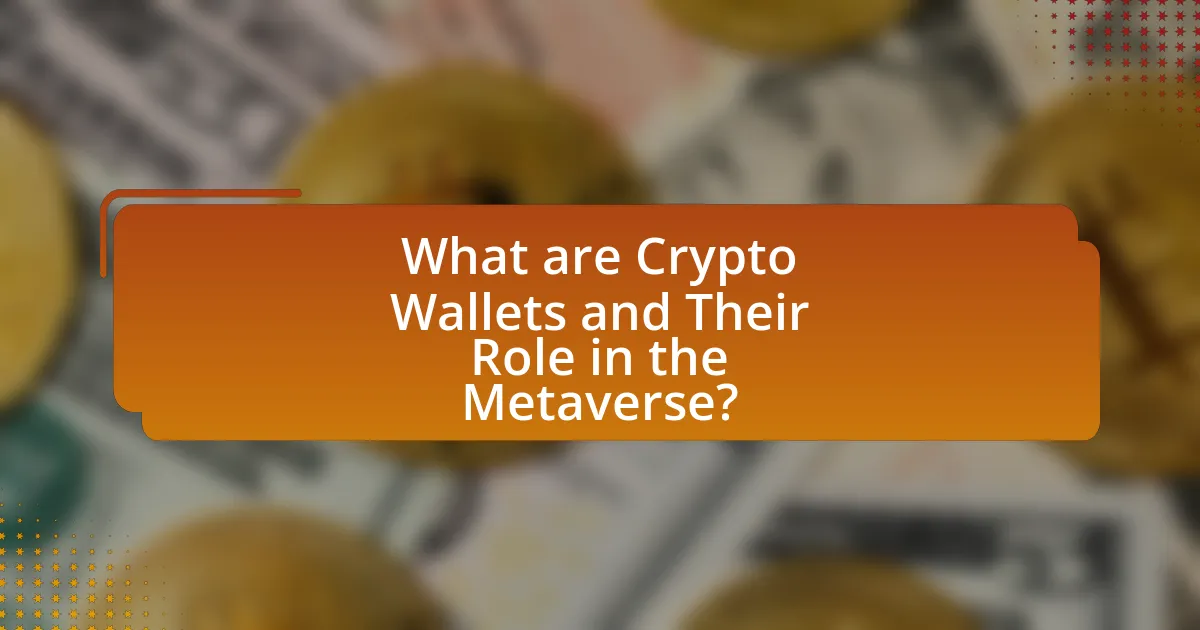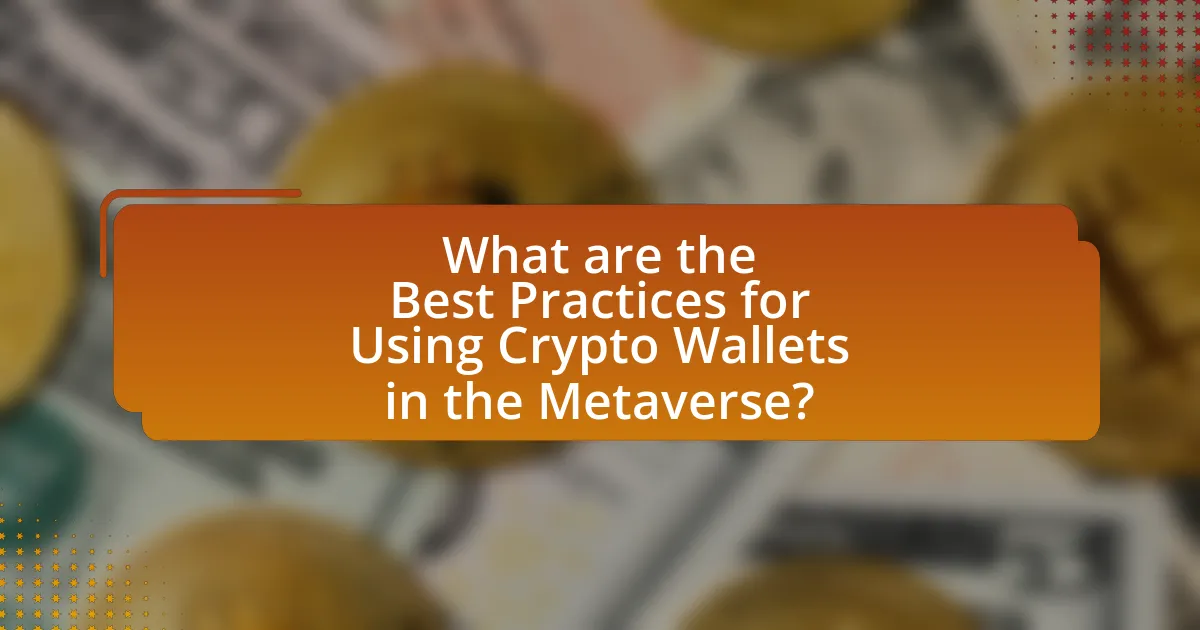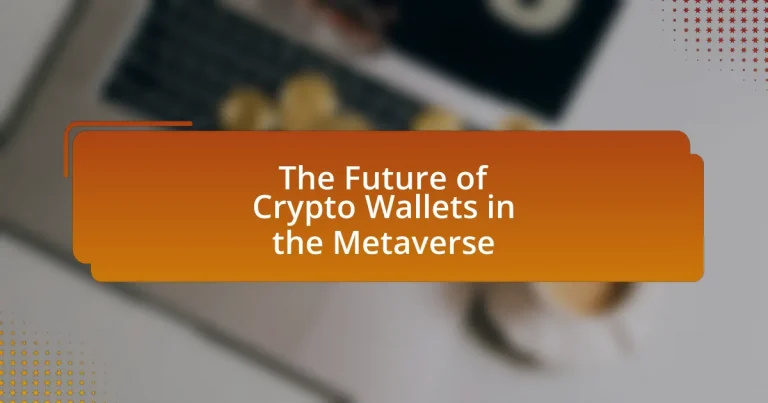Crypto wallets are essential digital tools that enable users to securely store, manage, and transact cryptocurrencies within the Metaverse. This article explores the functionality of crypto wallets in virtual environments, detailing their role in facilitating transactions involving virtual assets such as NFTs and in-game currencies. It examines the various types of wallets available, including hot, cold, and hardware wallets, and discusses their security features, advantages, and disadvantages. Additionally, the article highlights the integration of decentralized finance (DeFi) platforms, emerging trends, regulatory challenges, and best practices for users to enhance their experience and ensure the security of their digital assets in the evolving Metaverse landscape.

What are Crypto Wallets and Their Role in the Metaverse?
Crypto wallets are digital tools that allow users to store, manage, and transact cryptocurrencies securely. In the context of the metaverse, these wallets play a crucial role by enabling users to buy, sell, and trade virtual assets, such as NFTs and in-game currencies, seamlessly across various platforms. The integration of crypto wallets in the metaverse facilitates ownership verification and enhances user experiences by providing a secure means of conducting transactions, thereby supporting the growing economy within virtual environments.
How do Crypto Wallets function within the Metaverse?
Crypto wallets function within the Metaverse by enabling users to securely store, manage, and transact digital assets such as cryptocurrencies and non-fungible tokens (NFTs). These wallets facilitate interactions in virtual environments by allowing users to purchase virtual goods, participate in decentralized finance (DeFi) activities, and engage in social experiences that require digital currency. For instance, a user can buy virtual real estate or avatar accessories using their crypto wallet, which connects to various platforms within the Metaverse. The integration of blockchain technology ensures that transactions are transparent and immutable, providing users with a secure means to manage their digital identities and assets.
What types of transactions can be conducted using Crypto Wallets in the Metaverse?
Crypto wallets in the Metaverse enable various types of transactions, including purchasing virtual real estate, trading non-fungible tokens (NFTs), and making in-game purchases. Users can buy, sell, or trade digital assets such as avatars, skins, and virtual goods using cryptocurrencies stored in their wallets. Additionally, crypto wallets facilitate peer-to-peer transactions, allowing users to send and receive funds directly without intermediaries. The integration of blockchain technology ensures secure and transparent transactions, which is essential for maintaining trust in virtual environments.
How do Crypto Wallets ensure security in the Metaverse?
Crypto wallets ensure security in the Metaverse through advanced encryption, multi-factor authentication, and decentralized storage. These wallets utilize cryptographic techniques to protect private keys, which are essential for accessing and managing digital assets. For instance, many wallets implement AES-256 encryption, a standard that secures data by converting it into an unreadable format without the correct key. Additionally, multi-factor authentication adds an extra layer of security by requiring users to verify their identity through multiple methods, such as SMS codes or biometric scans. Furthermore, decentralized storage minimizes the risk of hacks by distributing data across a network rather than storing it in a single location, making it harder for attackers to compromise. These measures collectively enhance the security of crypto wallets in the Metaverse, safeguarding users’ assets against unauthorized access and cyber threats.
What are the different types of Crypto Wallets available for Metaverse users?
There are three main types of crypto wallets available for Metaverse users: hot wallets, cold wallets, and hardware wallets. Hot wallets are connected to the internet, allowing for quick access and transactions, making them suitable for frequent trading and interactions within the Metaverse. Cold wallets, on the other hand, are offline storage solutions that provide enhanced security for long-term asset holding, protecting users from online threats. Hardware wallets are a specific type of cold wallet that store private keys on a physical device, offering a high level of security while still allowing users to interact with the Metaverse when needed. These wallet types cater to different user needs, balancing convenience and security in the evolving landscape of digital assets within virtual environments.
What are the advantages and disadvantages of hot wallets in the Metaverse?
Hot wallets in the Metaverse offer the advantage of convenience and accessibility, allowing users to quickly access and manage their digital assets for transactions and interactions within virtual environments. This immediacy is crucial for engaging in real-time activities, such as trading or purchasing virtual goods. However, the primary disadvantage of hot wallets is their vulnerability to cyberattacks, as they are connected to the internet, making them susceptible to hacking and phishing attempts. According to a report by Chainalysis, in 2021, over $3.2 billion was stolen from hot wallets due to security breaches, highlighting the risks associated with their use.
How do cold wallets provide enhanced security for Metaverse assets?
Cold wallets provide enhanced security for Metaverse assets by storing private keys offline, which significantly reduces the risk of hacking and unauthorized access. Unlike hot wallets, which are connected to the internet and vulnerable to cyber threats, cold wallets, such as hardware wallets or paper wallets, keep sensitive information isolated from online environments. This offline storage method protects assets from malware and phishing attacks, as evidenced by the fact that over 90% of cryptocurrency thefts occur through online vulnerabilities. By utilizing cold wallets, users can safeguard their Metaverse assets against the increasing prevalence of cybercrime in digital environments.
Why is the integration of Crypto Wallets crucial for the Metaverse’s future?
The integration of crypto wallets is crucial for the Metaverse’s future because it enables secure, decentralized transactions and ownership of digital assets. Crypto wallets facilitate the buying, selling, and trading of virtual goods and services, which are essential for a thriving Metaverse economy. According to a report by Grayscale, the Metaverse economy could reach $1 trillion in annual revenue, highlighting the importance of efficient financial systems. Furthermore, the use of crypto wallets allows users to maintain control over their assets, fostering trust and encouraging participation in virtual environments.
How do Crypto Wallets facilitate user interactions in virtual environments?
Crypto wallets facilitate user interactions in virtual environments by enabling secure transactions and ownership verification of digital assets. These wallets store private keys that allow users to access and manage their cryptocurrencies and NFTs, essential for participating in virtual economies. For instance, in metaverse platforms like Decentraland, users utilize crypto wallets to buy virtual real estate, trade digital goods, and engage in decentralized finance activities. The integration of blockchain technology ensures that all transactions are transparent and immutable, fostering trust among users. Additionally, wallets often support various tokens and assets, enhancing interoperability across different virtual environments, which is crucial for seamless user experiences.
What impact do Crypto Wallets have on digital asset ownership in the Metaverse?
Crypto wallets significantly enhance digital asset ownership in the Metaverse by providing secure, decentralized storage and management of virtual assets. These wallets enable users to own, trade, and transfer assets like NFTs and cryptocurrencies without relying on centralized authorities, thus ensuring true ownership and control. For instance, according to a report by Chainalysis, the decentralized finance (DeFi) sector, which heavily utilizes crypto wallets, has seen a surge in user adoption, indicating a growing trend towards self-custody of digital assets. This shift empowers users, as they can directly interact with the Metaverse’s economy, facilitating seamless transactions and ownership verification through blockchain technology.

What are the Emerging Trends in Crypto Wallets for the Metaverse?
Emerging trends in crypto wallets for the Metaverse include enhanced interoperability, multi-chain support, and integration of decentralized finance (DeFi) features. Interoperability allows users to seamlessly transact across different blockchain networks, facilitating a more fluid experience in the Metaverse. Multi-chain support enables wallets to manage assets from various blockchains, catering to the diverse ecosystems within the Metaverse. Additionally, the integration of DeFi features, such as staking and lending, empowers users to maximize their assets while engaging in virtual environments. These trends are driven by the increasing demand for user-friendly and versatile financial tools in digital spaces, as evidenced by the growing number of wallet providers adapting to these needs.
How is the user experience evolving for Crypto Wallets in the Metaverse?
The user experience for crypto wallets in the Metaverse is evolving through enhanced integration, user-friendly interfaces, and increased security measures. As virtual environments become more immersive, wallets are being designed to seamlessly interact with various platforms, allowing users to manage assets effortlessly across different virtual spaces. For instance, the introduction of decentralized finance (DeFi) applications within the Metaverse enables users to conduct transactions and access financial services directly through their wallets, streamlining the process. Additionally, advancements in biometric authentication and multi-signature features are improving security, making users feel more confident in managing their digital assets. This evolution is supported by the growing adoption of blockchain technology and the increasing demand for secure, efficient financial tools in virtual environments.
What innovations are being introduced to enhance wallet usability?
Innovations enhancing wallet usability include biometric authentication, multi-chain support, and user-friendly interfaces. Biometric authentication, such as fingerprint and facial recognition, increases security while simplifying access for users. Multi-chain support allows wallets to manage various cryptocurrencies across different blockchain networks, improving flexibility and convenience. User-friendly interfaces, often incorporating intuitive design and streamlined navigation, enhance the overall experience, making it easier for users to manage their assets. These advancements are crucial as the adoption of crypto wallets grows in the Metaverse, where seamless transactions and security are paramount.
How are mobile Crypto Wallets adapting to the Metaverse landscape?
Mobile crypto wallets are adapting to the Metaverse landscape by integrating features that facilitate seamless transactions and enhance user experience within virtual environments. These wallets are incorporating support for various cryptocurrencies and NFTs, enabling users to easily buy, sell, and trade digital assets in the Metaverse. For instance, wallets like MetaMask and Trust Wallet have introduced functionalities that allow users to connect directly with decentralized applications (dApps) in virtual worlds, streamlining the process of engaging in virtual economies. Additionally, mobile wallets are enhancing security measures, such as biometric authentication and multi-signature options, to protect users’ assets in increasingly complex digital ecosystems. This adaptation is evidenced by the growing number of partnerships between wallet providers and Metaverse platforms, which aim to create a more integrated and user-friendly experience for digital asset management.
What role do decentralized finance (DeFi) platforms play in Crypto Wallets within the Metaverse?
Decentralized finance (DeFi) platforms enhance crypto wallets within the Metaverse by enabling seamless financial transactions and services without intermediaries. These platforms allow users to lend, borrow, and trade assets directly through their wallets, facilitating a more integrated and efficient economic environment in virtual spaces. For instance, DeFi protocols like Uniswap and Aave provide liquidity and yield farming opportunities, which can be accessed directly from crypto wallets, thus promoting user engagement and financial activity in the Metaverse. This integration supports the growth of virtual economies, as users can manage their digital assets and participate in financial activities without relying on traditional banking systems.
How do DeFi integrations enhance the functionality of Crypto Wallets?
DeFi integrations enhance the functionality of crypto wallets by enabling users to access decentralized financial services directly within their wallets. This integration allows for seamless activities such as lending, borrowing, and earning interest on crypto assets without the need for intermediaries. For instance, wallets that support DeFi protocols can facilitate yield farming, where users can stake their assets to earn rewards, thus increasing the utility of their holdings. Additionally, DeFi integrations often provide users with real-time access to decentralized exchanges, enabling instant trading and liquidity provision. This functionality is supported by the growing number of DeFi protocols, which collectively managed over $100 billion in total value locked as of 2023, demonstrating the significant impact of DeFi on enhancing wallet capabilities.
What are the risks associated with using DeFi-enabled Crypto Wallets in the Metaverse?
The risks associated with using DeFi-enabled crypto wallets in the Metaverse include smart contract vulnerabilities, regulatory uncertainties, and potential loss of funds due to hacking. Smart contracts, which automate transactions, can contain bugs or exploits that malicious actors may leverage, leading to financial losses. Regulatory uncertainties arise as governments worldwide are still formulating policies regarding DeFi, which can affect the legality and operation of these wallets. Additionally, the Metaverse’s immersive nature can lead to phishing attacks, where users may inadvertently disclose sensitive information, resulting in unauthorized access to their wallets and loss of assets.
What are the regulatory challenges facing Crypto Wallets in the Metaverse?
Crypto wallets in the Metaverse face significant regulatory challenges primarily due to the lack of a unified legal framework governing digital assets across jurisdictions. This fragmentation complicates compliance for wallet providers, as they must navigate varying regulations related to anti-money laundering (AML), know your customer (KYC) requirements, and consumer protection laws. For instance, the Financial Action Task Force (FATF) has issued guidelines that require virtual asset service providers to implement robust AML measures, yet the adoption of these guidelines varies widely among countries. Additionally, the evolving nature of digital currencies and the Metaverse itself creates uncertainty, as regulators struggle to keep pace with technological advancements, leading to potential gaps in oversight and enforcement.
How do regulations impact the development of Crypto Wallets?
Regulations significantly impact the development of crypto wallets by establishing legal frameworks that dictate compliance requirements, security standards, and user privacy protections. For instance, regulations such as the Financial Action Task Force (FATF) guidelines require crypto wallet providers to implement Know Your Customer (KYC) and Anti-Money Laundering (AML) measures, which can increase operational costs and complexity for developers. Additionally, the European Union’s Markets in Crypto-Assets (MiCA) regulation aims to create a unified regulatory environment, influencing how wallets are designed to ensure they meet specific legal obligations. These regulatory measures can either foster innovation by providing clear guidelines or stifle development due to increased compliance burdens.
What measures can be taken to ensure compliance in the Metaverse?
To ensure compliance in the Metaverse, implementing robust regulatory frameworks is essential. These frameworks should include clear guidelines for user data protection, financial transactions, and content moderation. For instance, the General Data Protection Regulation (GDPR) in Europe sets a precedent for data privacy that can be adapted for virtual environments. Additionally, establishing identity verification processes can help prevent fraud and ensure that users adhere to community standards. The integration of blockchain technology can also enhance transparency in transactions, making it easier to track compliance with regulations. Furthermore, regular audits and assessments of virtual platforms can help identify and rectify compliance issues proactively.

What are the Best Practices for Using Crypto Wallets in the Metaverse?
The best practices for using crypto wallets in the Metaverse include ensuring strong security measures, regularly updating wallet software, and using hardware wallets for significant amounts of cryptocurrency. Strong security measures, such as enabling two-factor authentication and using complex passwords, protect against unauthorized access. Regularly updating wallet software helps safeguard against vulnerabilities, as updates often include security patches. Additionally, hardware wallets, which store private keys offline, provide enhanced security for larger holdings, reducing the risk of hacks associated with online wallets. These practices are essential for maintaining the integrity and safety of digital assets in the evolving landscape of the Metaverse.
How can users ensure the security of their Crypto Wallets in the Metaverse?
Users can ensure the security of their crypto wallets in the Metaverse by implementing strong security practices such as using hardware wallets, enabling two-factor authentication, and regularly updating software. Hardware wallets store private keys offline, significantly reducing the risk of hacking, as evidenced by a report from the Cybersecurity & Infrastructure Security Agency, which highlights that offline storage is one of the most secure methods for protecting digital assets. Additionally, enabling two-factor authentication adds an extra layer of security by requiring a second form of verification, which has been shown to reduce unauthorized access by up to 99.9%. Regularly updating wallet software ensures that users benefit from the latest security patches and features, as outdated software can be vulnerable to exploits.
What steps should be taken to protect private keys and recovery phrases?
To protect private keys and recovery phrases, users should implement strong security measures such as using hardware wallets, enabling two-factor authentication, and securely storing recovery phrases offline. Hardware wallets provide a secure environment for private keys, minimizing exposure to online threats. Two-factor authentication adds an additional layer of security, making unauthorized access more difficult. Storing recovery phrases offline, such as in a safe or a secure physical location, prevents them from being compromised through online attacks. These steps are essential as they significantly reduce the risk of theft and loss, which is critical in the context of cryptocurrency management.
How can users recognize and avoid common scams related to Crypto Wallets?
Users can recognize and avoid common scams related to crypto wallets by being vigilant about suspicious communications and verifying the authenticity of wallet services. Scammers often impersonate legitimate companies through phishing emails or fake websites, so users should always check URLs and ensure they are accessing official sites. Additionally, users should enable two-factor authentication and avoid sharing private keys or recovery phrases, as these are critical for wallet security. According to a report by the Federal Trade Commission, consumers lost over $80 million to cryptocurrency scams in 2021, highlighting the importance of caution and awareness in protecting assets.
What tips can enhance the overall experience of using Crypto Wallets in the Metaverse?
To enhance the overall experience of using crypto wallets in the Metaverse, users should prioritize security, user interface, and interoperability. Implementing two-factor authentication and using hardware wallets can significantly reduce the risk of hacks, as studies show that 80% of crypto thefts occur due to poor security practices. A user-friendly interface allows for easier navigation and transaction management, which is crucial given that 70% of users abandon platforms due to complexity. Additionally, ensuring that the wallet supports multiple cryptocurrencies and integrates seamlessly with various Metaverse platforms can improve usability, as the Metaverse is characterized by diverse ecosystems.
How can users effectively manage multiple wallets for different assets?
Users can effectively manage multiple wallets for different assets by utilizing wallet management tools and software that aggregate various wallets into a single interface. These tools allow users to track balances, transactions, and asset performance across different wallets, simplifying the management process. For instance, platforms like Exodus and Atomic Wallet provide multi-currency support and user-friendly dashboards, enabling users to view and manage their assets seamlessly. Additionally, implementing security measures such as two-factor authentication and hardware wallets can protect assets while managing multiple wallets. According to a report by Chainalysis, the use of wallet management tools has increased by 40% among crypto users, highlighting their effectiveness in asset management.
What resources are available for staying updated on Crypto Wallet developments in the Metaverse?
To stay updated on Crypto Wallet developments in the Metaverse, individuals can utilize several key resources. Industry news websites such as CoinDesk and CoinTelegraph provide timely articles and analyses on cryptocurrency and wallet innovations. Additionally, following social media channels and forums like Twitter and Reddit can offer real-time updates and community insights. Engaging with platforms like GitHub allows users to track ongoing projects and developments in crypto wallet technology. Furthermore, subscribing to newsletters from blockchain-focused organizations can deliver curated information directly to inboxes. These resources collectively ensure access to the latest trends and advancements in the field.


